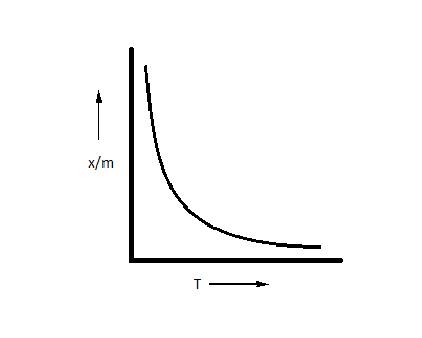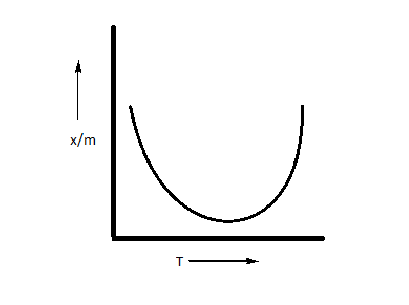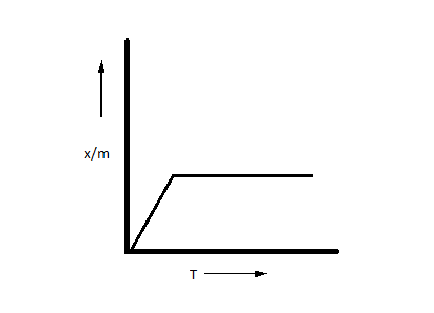
Which plot is the adsorption isobar for chemisorption where $x$ is the amount of gas adsorbed on mass $m$ (at constant pressure) at temperature T?
A. 
B.
C.
D.
Answer
219k+ views
Hint: The adsorption involving a chemical reaction between the surface and the adsorbate is called chemisorption. It can also be regarded as a chemical reaction occurring between the adsorbate and the adsorbent.
Complete step by step answer:
During chemisorption, new bonds (ionic or covalent) are generated at the adsorbent surface. It includes processes like corrosion and reactions using heterogeneous catalysts. It requires activation energy in order to occur. It is an irreversible process and can be regarded as a chemical reaction occurring between the adsorbate and the adsorbent. As chemisorption requires activation energy so like any other chemical reaction, we can say that by increasing the temperature, chemisorption increases, i.e. $\dfrac{x}{m}$ increases.
Adsorption is also a spontaneous reaction, i.e. it occurs at room temperature. So, we can say that the bond formation energy between the adsorbate and adsorbent is low. This also means that adsorption is an exothermic reaction. As we know that according to Le-Chartelier’s principle, as the temperature of an exothermic reaction is increased, the reaction proceeds backwards, i.e. in this case, adsorption decreases. So with increase in temperature, $\dfrac{x}{m}$ also decreases.
So, combining the two factors, we can conclude that if we increase the temperature, in the case of chemisorption:
$\dfrac{x}{m}$ increases as heat is absorbed by the particles in the system to achieve required activation energy and thus, higher rates of adsorption.
$\dfrac{x}{m}$ decreases after a certain point when all the particles already possess the required amount of activation energy, as adsorption being an exothermic process decreases with increase in temperature.
The correct option is option D, i.e. $\dfrac{x}{m}$ first increases and then decreases.
Note:
In the case of physisorption, the bonds formed are due to Vander Waal force of attraction. The reaction is reversible and not dependent on activation energy and thus, only decreases with the increase in temperature. In the case of chemisorption, the factors of both activation energy and exothermic process are taken into account.
Complete step by step answer:
During chemisorption, new bonds (ionic or covalent) are generated at the adsorbent surface. It includes processes like corrosion and reactions using heterogeneous catalysts. It requires activation energy in order to occur. It is an irreversible process and can be regarded as a chemical reaction occurring between the adsorbate and the adsorbent. As chemisorption requires activation energy so like any other chemical reaction, we can say that by increasing the temperature, chemisorption increases, i.e. $\dfrac{x}{m}$ increases.
Adsorption is also a spontaneous reaction, i.e. it occurs at room temperature. So, we can say that the bond formation energy between the adsorbate and adsorbent is low. This also means that adsorption is an exothermic reaction. As we know that according to Le-Chartelier’s principle, as the temperature of an exothermic reaction is increased, the reaction proceeds backwards, i.e. in this case, adsorption decreases. So with increase in temperature, $\dfrac{x}{m}$ also decreases.
So, combining the two factors, we can conclude that if we increase the temperature, in the case of chemisorption:
$\dfrac{x}{m}$ increases as heat is absorbed by the particles in the system to achieve required activation energy and thus, higher rates of adsorption.
$\dfrac{x}{m}$ decreases after a certain point when all the particles already possess the required amount of activation energy, as adsorption being an exothermic process decreases with increase in temperature.
The correct option is option D, i.e. $\dfrac{x}{m}$ first increases and then decreases.
Note:
In the case of physisorption, the bonds formed are due to Vander Waal force of attraction. The reaction is reversible and not dependent on activation energy and thus, only decreases with the increase in temperature. In the case of chemisorption, the factors of both activation energy and exothermic process are taken into account.
Recently Updated Pages
Is PPh3 a strong ligand class 12 chemistry JEE_Main

Full name of DDT is A 111trichloro22bispchlorophenyl class 12 chemistry JEE_Main

Sodium acetate on heating with soda lime produce A class 12 chemistry JEE_Main

Find the isoelectric point pI of Lysine A 556 B 974 class 12 chemistry JEE_Main

The order of basicity among the following compounds class 12 chemistry JEE_Main

The number of isomers in C4H10O are a7 b8 c6 d5 class 12 chemistry JEE_Main

Trending doubts
JEE Main 2026: Application Form Open, Exam Dates, Syllabus, Eligibility & Question Papers

Derivation of Equation of Trajectory Explained for Students

Hybridisation in Chemistry – Concept, Types & Applications

Understanding the Angle of Deviation in a Prism

Understanding Collisions: Types and Examples for Students

Understanding Atomic Structure for Beginners

Other Pages
NCERT Solutions For Class 12 Chemistry Chapter 1 Solutions - 2025-26

NCERT Solutions for Class 12 Chemistry Chapter Chapter 7 Alcohol Phenol and Ether

NCERT Solutions ForClass 12 Chemistry Chapter Chapter 8 Aldehydes Ketones And Carboxylic Acids

JEE Advanced Marks vs Ranks 2025: Understanding Category-wise Qualifying Marks and Previous Year Cut-offs

Haloalkanes and Haloarenes Class 12 Chemistry Chapter 6 CBSE Notes - 2025-26

Solutions Class 12 Chemistry Chapter 1 CBSE Notes - 2025-26




